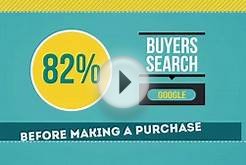Practically anywhere the eye can see, there's an ad begging for a second look. Whether it’s commercials, online ads, or those poor faces racking up "impressions" on bus benches, there’s no doubt we’ve grown a sense of numbness toward marketing messages over time.
Ad space online is no different; our natural reaction is “No thank you, ” even if, on some level, there was a hint of interest.
So how can Google Adwords, an increasingly saturated market that allows only 3 tiny lines of ad copy, help your site get viable leads?
It’s all about gaining - and holding - the right searcher's attention. This is one of the things we explore in our latest new ebook about advanced PPC strategies. But when used correctly, and efficiently, PPC ads can be an excellent complement to your inbound marketing strategies. Here’s how you can stand apart from the competition in the SERPs, and convince searchers you’re worth more than just a couple seconds.
Price Competitiveness: Show Them Your Value
There’s no way around it, particularly if you're an ecommerce marketer. Being price competitive should be a top priority when you're trying to get transactional clicks from PPC ads. Shoppers have become increasingly smart and savvy online, especially when, in an instant, they can sort results by the lowest price and compare five different stores selling your same products.
You don’t always have to be the absolute lowest price, but be close enough to allow other factors that set you apart from the “other guys” play a role in a searcher's decision-making process.
Compelling Marketing: Sum the Value of Your Offer Into 95 Characters
Once you’re in the ballpark range of being competitive on pricing, the second question becomes, “Why should I buy from you?” This is a question every marketer has to ask to determine a solid value proposition.
Do your best to resolve this conflict by giving searchers more value than they think will be possible elsewhere. Effective marketing requires both an attuned sense of the audience you're attempting to reach, and a message capable of actually reaching them.
So what’s the catch? You have 95 characters to work with. With a 25-character headline and two 35-character description lines, you must be concise and extremely utilitarian with your ad copy.
In order to meet the needs of your target audience most efficiently, you'll need to incorporate as many of the following elements as possible, as concisely as possible:
1) Qualifiers
Make sure that the people clicking on your ads are qualified customers that plan on making a purchase. The most effective way to qualify your traffic looking to make a transaction is by including price explicitly in your ad. The vast majority of purchase decisions online are made strictly based on price. Whether he/she is a ‘bargain hunter’ or a ‘luxury shopper, ’ chances are your customer has a price in mind for the product or service they're searching for. Include price directly in the headline of your ad.
2) Call-to-Action
This one is simple - tell your consumer what you want them to do! Incorporate a sense of urgency or a specific sales process like: “Save on Flowers Today!” or “Limited Time Flower Sale.”
3) Risk Reduction
It's also important to remember that shopping online is still a relatively new phenomenon. Many of your customers may be making their first purchase online with you, have limited experience with online shopping, and/or have never interacted with your website. Reduce any worry of risk involved in an online purchase by mentioning special shipping deals, as well as free return policies or lifetime warranties in your ad - these make customers more comfortable and encourage them to take action.
4) Credibility
Further trust is engendered by building credibility. Have you been in business 50 years? Are you recognized by any highly regarded associations? Any awards? Put anything you can in the ad that will solidify that you are a legitimate and trusted vendor.
5) Product Features
More than likely your customer already has a good idea of what your product is and what it does. If you have a particularly unique or new product, though, you’ll probably need to explain some features in the ad.
Below are a few examples which utilize these best practices.
These strategies can set you apart from your competitors and allow you to dominate the market without the need for aggressive over-bidding. Google makes money every time consumers click on PPC ads. You, however, only make money if the revenue gained from sales through PPC is higher than the total costs accumulated while getting that customer.
Be clear about what makes you special, and whatever it is, make sure the message gets through. You have 95 characters ... you can’t include everything in one ad. So make a few different ads that incorporate different elements, and test them against each other to see what works best. Save the music, choreography, and fancy witticisms for your blog ;-)
The Perception of “Getting a Deal”: Make Customers Feel Good About Their Purchase
Never underestimate the power of a good deal, even if it’s just the perception of a good deal. Have you ever heard anyone say they got ripped off ... and it didn’t bother them?
Didn’t think so.
A visual representation of how great a deal someone is getting can go a long way in adding perceived value and prompting a purchase. Having strikethroughs on an original price along with the “sale price, " for example, naturally stands out and makes shoppers feel like they’ve already saved money by choosing to buy from you. It’s a simple and visual way to incentivize purchasing from you over someone else.
Having a combination of price competitiveness, compelling marketing, perceived deals, and a conversion-friendly design that instills trust will put you in a great position to catch attention and close a sale, without visitors second-guessing your offer.
Chris Darabi is a Senior SEM Analyst for National Positions, an internet marketing company that specializes in . National Positions works with hundreds of companies and has been named to Inc. Magazine’s list of fastest growing privately held companies from 2009-2013. Chris specializes in PPC, ecommerce channel management, and web analytics.










